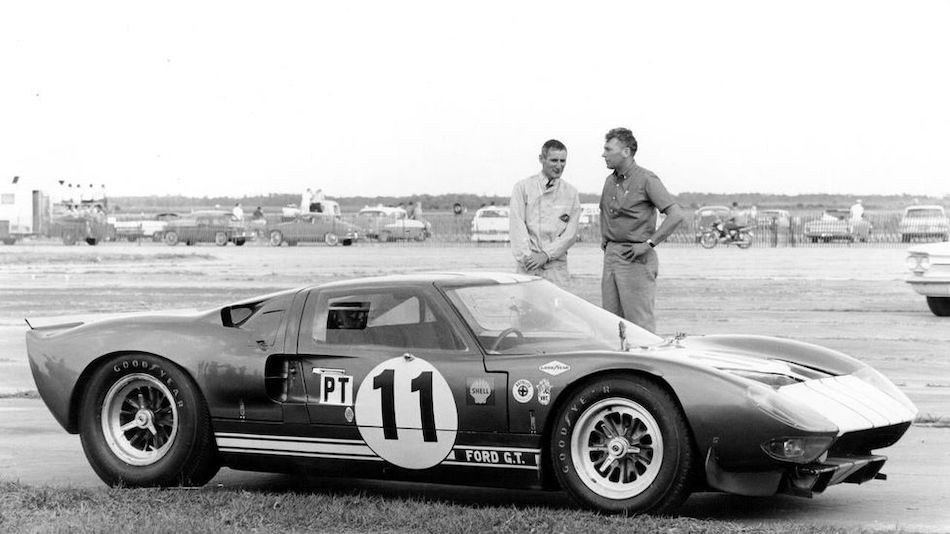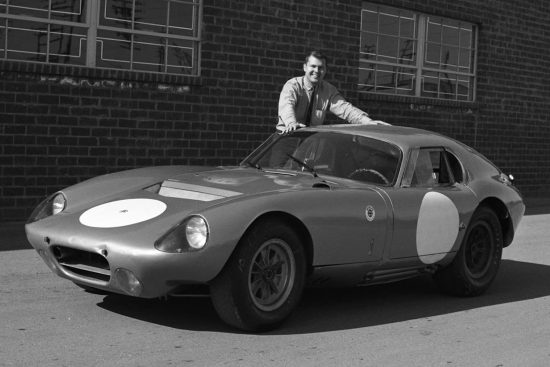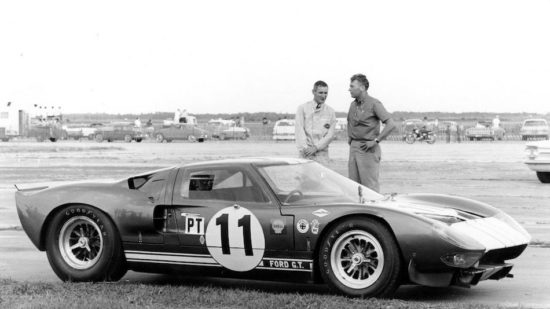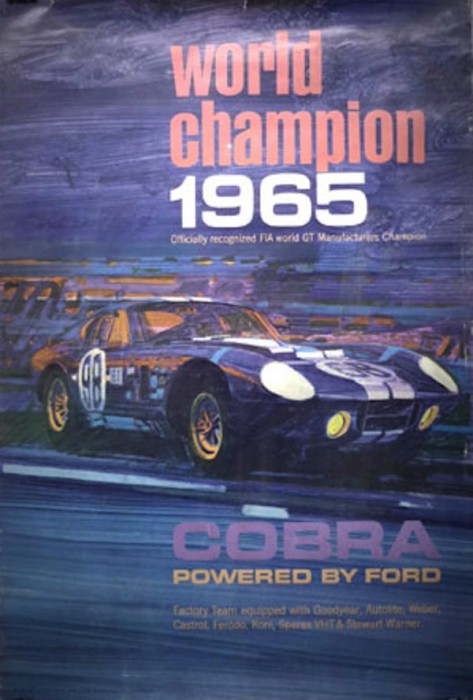by Wallace Wyss –
In the film Ford v Ferrari Ken Mles, portrayed by Christian Bale, an English immigrant to America, is depicted as an irascible trickster, always at war with the establishment. In the film, Carroll Shelby, played by Matt Damon, spends a great deal of time trying to keep Miles in line–from alienating sponsors or even other drivers.
Miles was wont to practice “psy-ops”–psychological warfare, making other drivers worried that this “old man” was in far better shape then they and more experienced.
Miles was a political animal as well, and got deep into the wars between different race sponsoring groups, so much so that at one time or another he was banned from one or the other. His racing career had ground to a halt in American amateur racing because of these political battles.
According to accounts by those who knew him in the ’50s and ’60s conflict was something Miles thrived on. First of all he was older than a lot of the other drivers and came to racing in America after having raced pre-war in his native England. He not only had European racing experience, but, having been in a tank crew in North Africa during WWII, he’d done it all and seen it all before he even set foot on a racetrack in America.
He came to Shelby in a competition of sorts, both competing for a development contract. Miles had established himself as an independent mechanic, and a skilled race driver. It was he who established the Sunbeam Alpine as a race car. Then Sunbeam paid him a mere 200 dollars to stuff a Ford 260 engine into a Sunbeam Alpine in the same way Shelby was doing it with Cobras. At the same time they also went to Shelby who by ’62 had the added patina of working with a giant auto-maker, Ford, and asked him to do the same thing. Shelby’s fee was a little higher–$10,000–but such was his reputation as a miracle worker, he could get it. Sunbeam went into production with Shelby’s version and that became the Tiger, which sold seven times more cars than Shelby did small block Cobras.
You would think Miles would be more than a little resentful that Shelby aced him out, but he wasn’t. When Shelby offered him a job as development driver and race driver for his factory Cobra race ream, Miles leapt at the opportunity. Partly, as the film shows, he had burned his bridges with amateur racing, and partly because it was a steady job, his mechanics shop impounded by the IRS.
He relished his new role because it showed his rival racers he still had what it took. Because he was 10 to 20 years older than the other Shelby drivers, he liked to pride himself in his physical prowess, always exercising, taking tea instead of unhealthy drinks and walking about with his shirt off as if to compare the state of his physique with all these young competitors.
He was the prima donna of Shelby’s crew of drivers. Specific cars would be reserved for him and set up his way. For instance he had rose jointed suspensions while the other team cars did not. He liked to drive experimental cars and make recommendations on what still needed to be done.
In the early ’50s, while still an independent, he had built some one off MG-powered cars called the Flying Shingle so he was a development engineer on his own projects before being hired on a Shelby. In the early 50s, he was as well known in California and on more than one occasion, Shelby had raced against him. Shelby first invited Miles to work on the Cobras, setting up the racing roadsters and later to oversee the coupe designed by young Pete Brock that became the Daytona.
Though Miles is not credited with engineering the big block Cobra, one of his significant developments was overseeing putting a big block 390 into a leaf sprung small block roadster just to see how the car would react to such an increase in horsepower and torque. The car was fairly uncontrollable at Sebring when it was entered there and Miles managed to find the only tree on the course and hit it. The car was bumped out in the pits, with Miles working all night even with damaged ribs. The car went back out with co-driver John Morton but blew its engine.
THE COBRA DAYTONA
At the same time as Shelby was thinking big block for the roadster, one of his employees, former GM styling intern Peter Brock was pressing him to adopt his fixed head coupe design, the original Cobra roadster, even with a fastback hardtop, could only do 175 mph but had terrible reliability when pushed that hard. Shelby, begrudgingly, set aside some money to build Brock’s baby.
Miles was assigned to work with Brock to develop the Daytona coupe, though most of the mechanics in the shop thought it a dumb design, not worth the time or money. It was almost punishment for Miles to work on a car everyone thought would be a turkey.
In Detroit most development engineers stay in the lab or the fabrication shop but Miles was unusual in not only helping develop all the components but in going out on the track and testing the effect of each redesigned part.
The Daytona, after some early problems with aerodynamics (partially solved by a rear spoiler), was a success and helped Shelby-American win the World’s Manufacturing Championship in 1965. But the Daytona was, in truth, only a stop-gap car. It couldn’t catch the mid-engined Ferrari prototypes which could do over 200 mph.
It was then, as the film shows, when Ford handed Shelby the already completed Ford GT40 and requested Shelby fix its flaws, Shelby handed that job to a small internal group including Miles and Phil Remington doing the engineering and Bob Bondurant and Bruce McLaren doing the test driving.
Miles was instrumental in overseeing the transitions from the 260 Ford GT engine to the 289, then from the 289 to the 427 that became the Mk.II. In the movie they show Miles back in Los Angeles listening to the 1965 Le Mans race on the radio but in reality he was driving a GT40 Mk.II at Le Mans in ’65 when the transmission packed up after four hours.
By ’66 he was back in Ford’s good graces enough to be in the team at Le Mans, driving a Mk. II big block. And of course the Big Moment in the movie is when he is “cheated” out of winning by agreeing in the final moments of the race with Ford management’s request to throttle back from his commanding lead so that three Ford GT racers could cross the finish line abreast. A better photo op, y’see.
But Miles sucked it up, lived with his accommodation, and stayed on Shelby’s crew, still as driver and development engineer.
THE J-CAR
So it was that he was tasked with testing the J-car, a later generation Ford GT with a “honeycomb” chassis glued together. It was nicknamed the J-car because it was built to conform to Appendix J of the FIA rules. It wasn’t that the Mk. II was obsolete but Ford believed that they had to make a major technological advance to stay ahead of Ferrari.
This was the car that Ford would campaign with at Le Mans in ’67, to prove that the ’66 LeMans victory was no lucky fluke. Miles was all for any experiment that would save several hundred pounds. One problem that Ford prototypes had compared to Ferrari throughout their six year war was that the Ford V8s weighed up to 200 lbs. more than the Ferrari V12s. And the Ferraris were more aerodynamic.
THE ACCIDENT
Maybe Riverside was the wrong track. The top speed you could run there was 185 mph. The car needed to consistently go 220 mph to beat the Ferraris in ’67. They should have been testing at Daytona, which has a banking where you can top 200.
Miles was the right driver. But the car came apart and he crashed and was thrown from the car. Though the exact cause of the accident was never determined, the car was hastily redesigned structurally, and made more robust. The shape changed too–to a fastback instead of the chopped off Kamm effect tail. The redesigned car was taken to Ford’s wind tunnel and tested to top speed to see that if the changes would help it stay on the ground (in the film for some reason they have more or less a J-car nose depicted in the accident car but not the correct rear styling).
Shelby-American earned a first at Le Mans in ’67 with the Mk. IV, the car that grew out of the J-car. So it was a lot of Miles’ early work that made that car a success. At that point, clutching their trophy for winning Le Mans in ’67, Ford decamped, and left endurance racing and the Gulf Team took the old GT40
design and improved it (going back to a small block and the earlier chassis and body shape) and won in ’68 and 69 (with the same damn car!)
So it makes you wonder. Was the J-car really necessary? No one will ever know, But Ford believed they had to innovate to stay ahead of Ferrari.
In sum, Miles knew Ford was on the edge as far as development, and the pressure was on him, being tasked with going faster than any American race car had gone before. But that’s where he wanted to be–on the edge.
He wouldn’t have had it any other way.
Let us know what you think in the Comments.
THE AUTHOR: Wallace Wyss is the author of three Shelby biographies. The last is SHELBY The Man, the Cars, the Legend available from Enthusiast books.









Thank you for the short history lesson. It’s great to read more about Ken Miles.
In a tragic case of happenstance….arguably Australia’s greatest touring car racer, Peter Brock , crashed and was killed driving a Daytona Coupe……designed by the American…Pete Brock.
Great article!
Loved learning more about Ken Miles. Christian Bale made him a larger than life character as it seemed he was. Thank you for letting us get to know him better. I wonder how his son is?